
FRÉDÉRIC MÜLLER
The M.A.D.Gallery introduces “Rides of the Wild,” a collection of eight images by Frédéric Müller, a young and talented Swiss artist with an extraordinarily creative mind. In this series, Müller brings his imagination to life, using his expertise in 3D art to morph classic cars into complementary transport for animals of the wild including a lion, a hippo, and an alligator. There’s even a ride for a panda!

“First and foremost, it’s about fun! Having fun and conveying fun,” Müller excitedly says as he describes his approach to art. Graduating with a bachelor’s degree in industrial and product design from the FHNW Academy of Art and Design in Switzerland, Müller was fascinated by the creative work behind shaping objects that surround us in our daily lives. After working as a designer, he discovered a passion that was not in product design but in using photography, computer-generated imagery (CGI), and 3D-visualisation techniques to make imaginative ideas become visual.
“Bringing concepts or products to life by showing them in photorealistic images, putting them into context, and telling stories of where and how the products would be of use in real life,” Müller explains.
A move to Amsterdam for a role as a 3D artist at a leading CGI production company came in 2013, providing a great experience and a mentor who brought out the best in him. Müller started publishing his work online, which resulted in positive attention and even magazine features. Gaining traction, his images were displayed next to the work of admired artists. Müller moved back to Switzerland to develop this opportunity, securing freelance projects for clients in the advertising industry while also developing his own projects.
RIDES OF THE WILD
A fast ride, a classy classic or a powerful pickup truck drive these animated beasts into a new habitat as Müller discovers his version of the ideal relationship between car and animal. By outfitting each “character” with personality traits, he transforms each being and conveyance using a variety of subtle accessories and shapes.
The sweeping, steel grey curves of an Aston Martin DB5 from 1963 perfectly pair with the voluptuous silhouette of a hippopotamus. Enhancing the semblance is a pair of “ears” ideally placed on the roof of the vehicle and a license plate personalized with ‘H1PP0’. Clients can choose between a print showing a straight-on view of the hippo-inspired Aston Martin or a scene portraying a suited-up hippo heading from his car into the office.
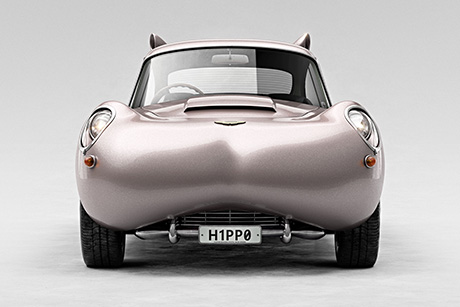
H1PP0 01
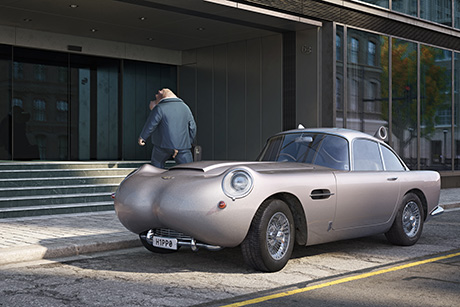
H1PP0 02
Ready for adventure? A lion behind the wheel of a transformed Ford F-250 with a pop-up camper in tow is just the thing. This heavy-duty pickup truck from 1967 fittingly takes on the feline features of a lion with a grill fashioned as a lion’s nose, a cab embellished with “ears,” and fur-coloured paint. Müller, a perfectionist when it comes to details, adorns the front of the truck with ‘ROAR’ across the hood (instead of ‘FORD’) and completes the license plate with ‘L10N’.
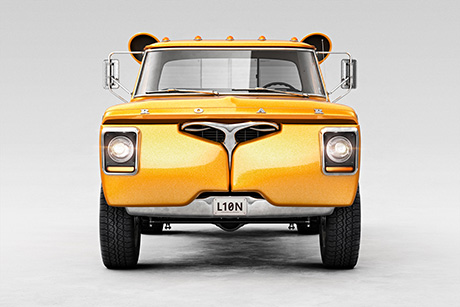
L10N 01
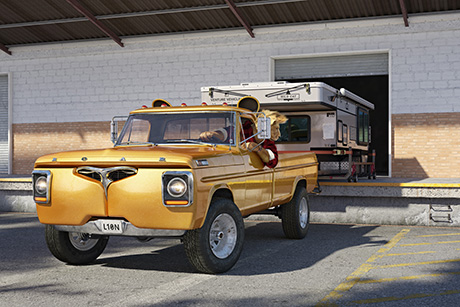
L10N 02
At the other end of the horsepower spectrum, a 1977 Fiat 600S playfully doubles as a panda bear with black and white features including a nose on the grill and ears peeking out from under the luggage rack. In Müller’s second panda-themed artwork, a globetrotting bear couple embark on a road trip; a fun detail is the luggage exploding with bamboo. Appearing lost, the driver holds a map while staring at illegible road signs. For added detail, the license plate is customized with ‘P4ND4’.

P4ND4 01

P4ND4 02
An alligator behind the wheel of a 1968 Chevrolet Corvette Stingray races around a corner at breakneck speed: the thrill-seeking reptile harmonizes with its powerful machine sporting an elongated frontend (similar to an alligator snout) and pointy teeth positioned alongside the personalized ‘G4T0R’ plate on the grill. The deep emerald colour of the classic car coordinates with the creature hanging out the window having the time of his life.
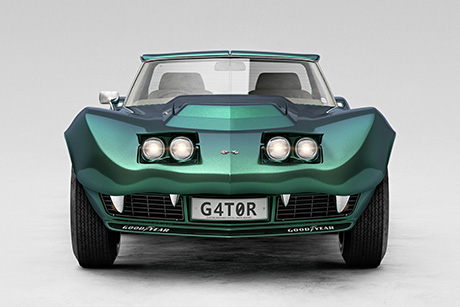
G4T0R 01
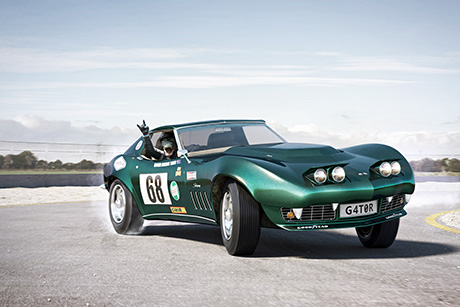
G4T0R 02
Each customized ride has a World Wide Fund for Nature (WWF) sticker thoughtfully placed on the window to remind us of the vulnerable status of these wild animals.
Here at the M.A.D.Gallery, we are both thrilled to present Müller’s playful compilation of clever 3D images and slightly obsessed with letting our imaginations run wild with potential storylines. “We always try to incorporate something that makes us, and hopefully those who discover our pieces, smile. Frédéric Müller’s work does exactly that!” Max Büsser, founder of MB&F and the M.A.D.Gallery, enthuses. “Not only is his work impressive and based on vintage cars, a theme close to my heart, but it recaptures a sense of whimsical and childhood that we need to hold on to.”
Two images are available for each of the four hybrid cars in either a frontend view or a coordinated setting with an animal driver. Each of the images is printed on fine paper, framed in white matte aluminium and protected by a two-millimetre-thick glass cover.
Each motif is available in two sizes, 128 x 90 cm and 70 x 50 cm with white margin (image 114 x 76 cm and 60 x 40 cm), limited to eight prints and one artist edition per size. And for those desiring to have all eight prints, 18 collector boxes of 51 x 41 cm prints with white margin will also be available (image 45 x 30 cm).
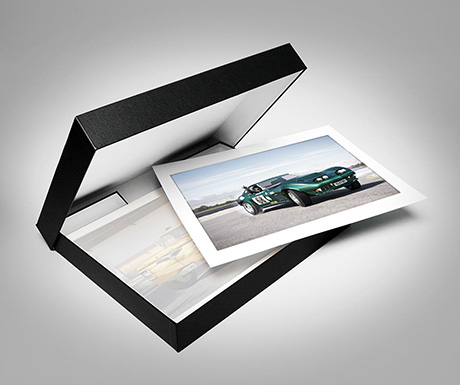
COLLECTOR BOX
CREATION PROCESS
Müller draws inspiration from everyday items and situations when creating his unique computer-generated imagery (CGI). In particular, this series came to life when a hippopotamus lamp in a second-hand store caught his eye. “The shape of the lamp looked like the front hood of a classic car,” Müller described. “I thought to myself: what if a car actually looked like a hippo? Most of my work begins with that simple question: what if? These two words are amazingly powerful in kicking off your imagination as they force you to think out of the norm.”
The hippo-esque Aston Martin continued to develop a unique personality and storyline in his mind, eventually unfolding into a series of four classic cars digitally morphed into wild animals with correlating characters.
Regarding the creation process, once the concepts are complete the next step in the digital imaging process is to design and build a 3D model of the cars using computer animation and modelling software.
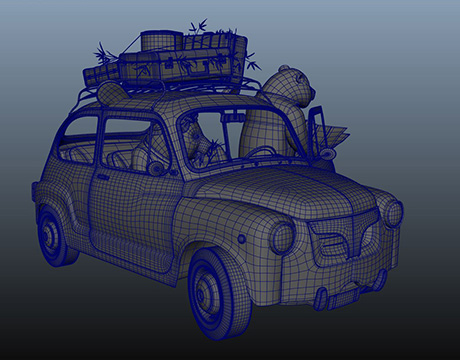
Completed 3D-Model
When modelling is completed, the 3D models are textured and shaded (defining their material properties), composited in the final scene by setting the camera angle, and the “lighting” arranged. The image is then test-rendered multiple times to fine tune the materials and lighting setup in order to achieve a photorealistic rendering.
The final steps, including colour grading and contrast, take place in Adobe Photoshop. Working in a 10,500-pixel format allows the finest of details to shine through, from the fur on the animals and dust on the wheels to squashed mosquitos on the windshield.

Grooming the Panda’s Fur
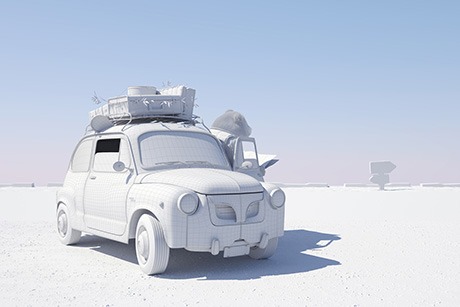
Preview Rendering for Lighting Setup
The process is not at all smoothly linear, each step requires several testing phases to produce the finished image Müller envisions. It takes lots of time to integrate the countless details: the “Rides of the Wild” series took nearly three years to complete from start to finish.

Today Müller’s studio time is split between a converted firefighter’s van and an office in Switzerland. “Being able to work remotely and getting out of the regular working environment is quite a boost for creative input,” he describes his time in his “Atelier on Wheels,” which runs on a large solar-powered battery. A substantial part of this series – research, development of the concept, sketching, and modelling of the cars – was created during adventurous road trips through Switzerland, Germany, Denmark, the Netherlands, and France.
Take a close look at the G4T0R and P4ND4 background: the sky and horizon line in the perspective images came from photographs captured by Müller while on the road. The largest resolution part of the work – including detailing, building of the CGI environments, and especially the rendering – were executed at the workspace in Switzerland, where he has more computing power.
The future is bright for this young digital artist who is dedicated to provoking feelings – especially happy ones – in those who observe his work. “To have viewers stop for a second and consider; what if this actually was real? To make people react, smile, laugh, reflect, and consider things from a different perspective. I loved (and still do love) the fact that you can express your creativity/ideas with little to no budget, except the time and effort you are willing to put into it,” Müller said.
MAKING-OF VIDEO
collection
Download the price list of the exhibition.


